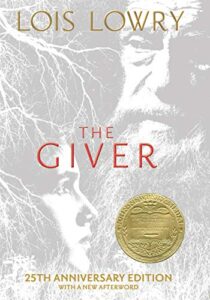The Giver (The Giver Quartet #1)
Lois Lowry
Clarion Books
Published April 26, 1993
Amazon | Bookshop | Goodreads
About The Giver
In Lois Lowry’s Newbery Medal–winning classic, twelve-year-old Jonas lives in a seemingly ideal world. Not until he is given his life assignment as the Receiver does he begin to understand the dark secrets behind his fragile community.
Life in the community where Jonas lives is idyllic. Designated birthmothers produce newchildren, who are assigned to appropriate family units. Citizens are assigned their partners and their jobs. No one thinks to ask questions. Everyone obeys. Everyone is the same. Except Jonas.
Not until he is given his life assignment as the Receiver of Memory does he begin to understand the dark, complex secrets behind his fragile community. Gradually Jonas learns that power lies in feelings. But when his own power is put to the test—when he must try to save someone he loves—he may not be ready. Is it too soon? Or too late?
Told with deceptive simplicity, this is the provocative story of a boy who experiences something incredible and undertakes something impossible. In the telling it questions every value we have taken for granted and reexamines our most deeply held beliefs.
The Giver has become one of the most influential novels of our time. Don’t miss the powerful companion novels in Lois Lowry’s Giver Quartet: Gathering Blue, Messenger, and Son.
My Review
I think this is the third or fourth time I’ve read this book, but definitely the first since I’ve been blogging. I would like to read and review all four books in the quartet. The second book, GATHERING BLUE, is one I’ve read before, but I haven’t read the other two.
One of the things that stood out to me this time reading the book is the way that Jonas’s role in the pivotal moment in the book is to ride his bike for scene after scene. Whereas back at home, the community members are reeling from the presence of Jonas’s memories, and the Giver is busy helping them process the new feelings.
Reading the book again as an adult, I find it an interesting choice that we follow Jonas out of the community and don’t witness the other community members experiencing those memories. Jonas really wanted his family and Fiona to experience the emotions and memories he experienced.
I love the book, though. Jonas journeys from passively following instructions and believing that the rules of the community are all for the best. As he learns about pain and loneliness (both from the Giver’s memories and his new role which mandates that he not speak about his training to anyone) he begins to question the way the community operates. He begins to wonder if the “sameness” which forbids anyone experiencing color, emotions, or individuality actually robs the community of something precious and valuable.
It’s an important idea, especially in the current conversations about book banning and restrictions on conversations about identity. Is there a point at which we harm ourselves by so completely sanitizing books and conversations? Do we diminish or lose the ability to empathize with others or process the existence of pain in the world this way?
Anyway. All that to say that I’m glad I reread THE GIVER. It’s been thirty years since the book was first published, and it still clearly has some important things to say.
Content Notes
Recommended for Ages 12 up.
Representation
Jonas and the Giver both have light eyes. That appears to be a marker for the ability to receive memories. No other race details given.
Profanity/Crude Language Content
None.
Romance/Sexual Content
Jonas feels attraction toward his friend Fiona.
Spiritual Content
The community celebrate the life of members when they reach a certain age, before a “ceremony of release” in which a community worker euthanizes the member with an injection.
Violent Content
Jonas watches a ceremony of release in which an adult injects and euthanizes a small child. Jonas experiences memories of war in which a soldier on a battlefield dies, crying out for water. He also experiences starvation and grief in memories.
Drug Content
Community leaders instruct Jonas to take a daily medication to stop any feelings of attraction/arousal.
Note: This post contains affiliate links, which do not cost you anything to use, but which help support this blog.
